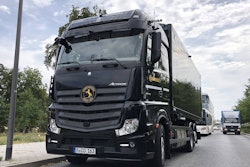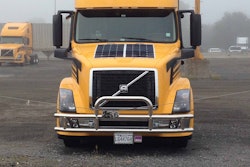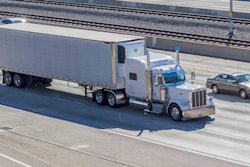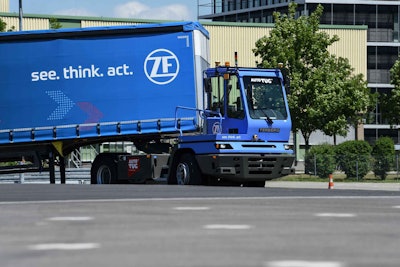
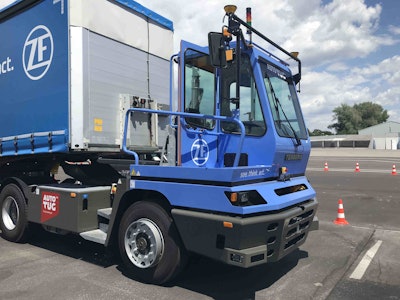
Running defined lanes within a restricted area, ZF CEO Wolf-Henning Scheider says yard trucks present an easy use case for moving freight from point A to point B autonomously.
“These vehicles can prevent maneuvering damage and downtimes,” he says, “which gives logistics companies a competitive advantage. The functions presented in our current innovation vehicles are applications that are in high demand and pay off quickly. Automated driving functions will see a wider use in commercial vehicles much earlier than in the passenger market. We believe autonomous technologies will become standard in areas where they increase operational security and reduce operational costs. Here, the fruit is hanging lower [due to the] immediate total cost of ownership benefits and less complexity.”
An extended sensor set enables the Terminal Yard Tractor to monitor its surroundings. ZF Head of Commercial Vehicles Fredrik Staedtler says the central computer – ZF proAI – coordinates the functions of longitudinal and lateral guidance, enabling the tractor to take the trailer from the truck and autonomously maneuver it to the ramp for loading and discharging.
“Once this has been completed, it takes the trailer back to the truck,” he says.
The yard tractor reaches its destination by an RFID coordinate system, which ZF’s Advanced Driver Assistance Systems (ADAS) Project Leader Alexander Banerjee says helps to localize the truck on-premise.
An on-site computer calculates the trajectory and transfers data to ZF’s Cloud Computing platform, OpenMatics, through a wireless signal. ZF proAI then processes the information in real time, converting it into instructions for the engine, steering system and brakes.
An intelligent and dynamic routing system tells the vehicle where to go, when to go, and what to do once it’s there. As soon as autonomous driving mode is activated, the vehicles automatically log on using the depot’s individual LTE/WLAN wireless signal as well as the on-board OpenMatics unit. The routing constantly checks and accounts for the vehicle’s current position and the routes of other vehicles on the premises, immediately adjusting its own routing when necessary.
The final mile frontier
The explosion of e-commerce and expedited delivery has put increasing pressure on the final mile segment.
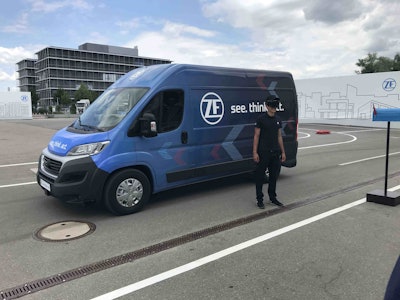 ZF’s electrically driven Innovation Van utilizes the finer points of an electric powertrain and couples them with advanced autonomous technologies, using a smart algorithm that takes into account customer requests in real time while also calculating the most efficient delivery route.
ZF’s electrically driven Innovation Van utilizes the finer points of an electric powertrain and couples them with advanced autonomous technologies, using a smart algorithm that takes into account customer requests in real time while also calculating the most efficient delivery route.ZF’s electrically driven Innovation Van utilizes the finer points of an electric powertrain and couples them with advanced autonomous technologies.
The Innovation Van leans on a cloud-based support system where data for each package on board is stored – like destination and preferred time of delivery – along with other information like shelf life of perishable goods.
Project Manager Georg Mihatsch says a smart algorithm takes this information, adds parameters like traffic conditions and energy consumption, and calculates the best delivery sequence in real time.
“Basically, the parcel itself finds the best way to get to the customer and the vehicle follows,” he says. “The parcel courier receives this information via mixed reality smartglasses. This allows them to review all relevant data.”
Gerhardt Gumpoltsberger, head of Innovation Management at ZF, says if two addresses are close together and the best delivery route is on foot, the Innovation Van can follow the courier “as if on a virtual leash. If there is no parking available outside an address, the courier can send the vehicle ahead to the next stop, where it will look for a parking space on its own,” he adds.
The driver can stop, move or otherwise control the van via smartglasses, even if they are standing on the sidewalk while the van drives away.
The Innovation Van is equipped with Level 4 autonomous driving functions and is designed to maneuver independently through urban surroundings. Gumpoltsberger says it has the ability to stay on course even on roads that lack clear markings, to recognize traffic lights and road signs and to react to sudden and hazardous conditions. The ZF sensor set consists of cameras, radar and Lidar sensors and the ZF proAI central computer can assume control by processing the data gathered by the sensors and enabling the vehicle to react appropriately.
Also at its Technology Day Wednesday, ZF showcased several new electrified components the company says will help shape the future of electrified and autonomous driving.
CeTrax lite and CeTrax mid
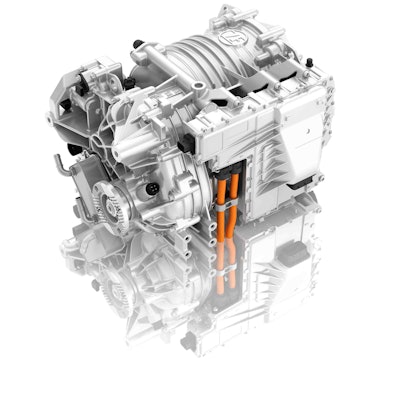 CeTrax lite, the electric central drive for delivery vans and light commercial vehicles up to 7.5 Tons, has a peak performance of 150 kW and a torque of 380 Nm.
CeTrax lite, the electric central drive for delivery vans and light commercial vehicles up to 7.5 Tons, has a peak performance of 150 kW and a torque of 380 Nm.CeTrax lite and CeTrax mid are all-electric plug and drive solutions designed for use in delivery vans, light commercial vehicles up to 16,500 pounds (CeTrax lite) and medium-duty commercial vehicles up to 42,000 pounds (CeTrax mid).
Mark Mohr, head of development for commercial vehicle technology at ZF, says what makes CeTrax lite and CeTrax mid unique is the electric central drive’s integrated design in which the electric motor, power electronics and transmission all form a compact unit within a shared housing.
He says this means the power electronics do not need to be wired separately with the electric motor since that connection already exists within the unit.
The CeTrax lite, an electric asynchronous traction motor, offers a peak power performance of 150 kW and 280 lb. ft. of torque.
With its two electric asynchronous traction motors in a parallel design, CeTrax mid’s peak performance is 300 kW, while a two- stage powershift transmission produces a torque of 560 lb. ft.
ReAX EPS
Based on ZF’s electromechanical steering concept for passenger cars, the ReAX EPS offers complete servo power of up to 50 lb. ft.
ZF Head of Commercial Vehicle Steering Systems at Mitja Schulz says fully electric steering is an important enabler for ADAS and automated drive functions that can help to improve safety as well as relieving drivers and improving logistics workflow.
cCAB active cabin suspension system, CALM update
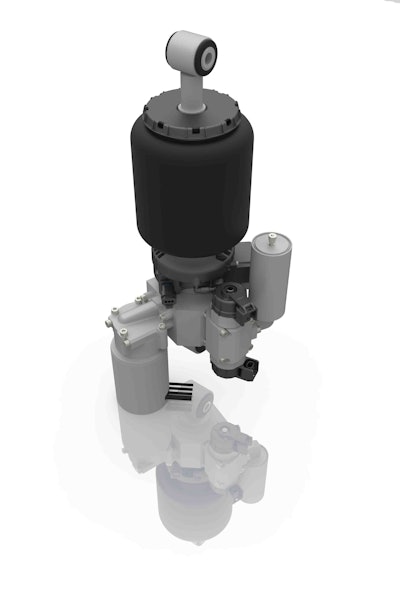 The active cabin suspension system cCAB: ZFs electronically controlled system can actively move the cabin and preemptively prevent undesired movements.
The active cabin suspension system cCAB: ZFs electronically controlled system can actively move the cabin and preemptively prevent undesired movements.Cabin suspensions are normally passive systems that react to road conditions by absorbing and damping movements with springs but when the truck doesn’t need a person to steer it down the road, the cabin becomes more of an shaky office space.
ZF’s electronically controlled active cCAB system actively adjusts the cabin, anticipating movements and working preemptively to compensate by balancing the roll and pitch behavior of the truck and the upward and downward movement of the cabin.
A special control unit receives signals about the vehicle’s state of motion from sensors and calculates a response within fractions of a second. It controls the four cCAB modules which then optimize the cabin motion sequence.
When cCAB is installed on the cabin’s four bearing points, it is able to actively rotate the cabin around the longitudinal and transverse axis and move it along the vertical axis to dampen it simultaneously.
ZF also plans to enhance its Cabin Air Leveling Module (CALM) with a new electronically controlled version that reduces air and energy consumption in the pneumatic cabin suspension system, which saves considerable energy in the vehicle itself. This means that the entire air system (compressor, accumulator, drier) can be designed to be smaller and lighter in weight. The compressor can also be operated electrically by integrating it into the eCALM system, which means it actuates when needed.



